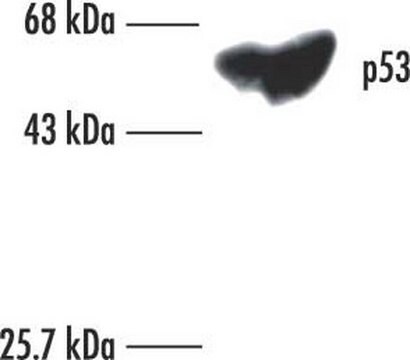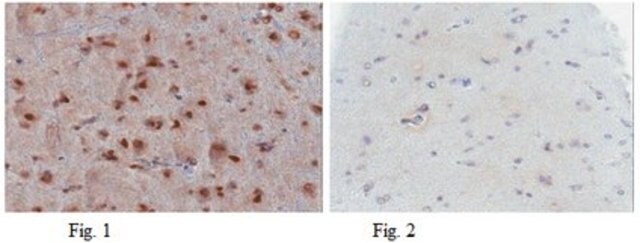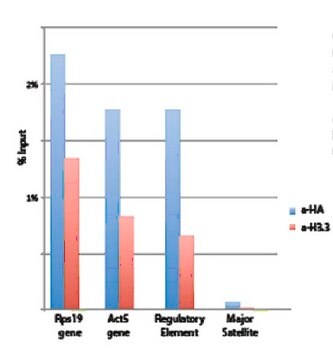MABE327
Anti-p53 (pantropic) Antibody, clone DO-1
clone DO-1, from mouse
Synonyme(s) :
Cellular tumor antigen p53, Antigen NY-CO-13, Phosphoprotein p53, Tumor suppressor p53
About This Item
Produits recommandés
Source biologique
mouse
Niveau de qualité
Forme d'anticorps
purified immunoglobulin
Type de produit anticorps
primary antibodies
Clone
DO-1, monoclonal
Espèces réactives
human
Technique(s)
immunocytochemistry: suitable
immunofluorescence: suitable
immunohistochemistry: suitable
immunoprecipitation (IP): suitable
western blot: suitable
Isotype
IgG2aκ
Numéro d'accès NCBI
Numéro d'accès UniProt
Conditions d'expédition
wet ice
Modification post-traductionnelle de la cible
unmodified
Informations sur le gène
human ... TP53(7157)
Description générale
Spécificité
Immunogène
Application
Immunohistochemistry Analysis: A 1:1,000 dilution from a representative lot detected p53 (pantropic) in human colorectal adenocarcinoma tissue and in human prostate cancer tissue.
Immunofluorescence Analysis: A 1:1,000 dilution from a representative lot detected p53 (pantropic) in human colorectal cancer cells.
Immunoprecipitation Analysis: A representative lot was used by an independent laboratory in radiolabelled HOS cell lysate (Vojtesek, B., et al. (1995). 71(6):1253-1256.).
Immunohistochemistry Analysis: A representative lot was used by an independent laboratory in primary breast carcinoma tissue (Beck, T., et al. (1995). Gynecol Oncol. 57(1):96-104.).
Epigenetics & Nuclear Function
Cell Cycle, DNA Replication & Repair
Qualité
Western Blot Analysis: 1 µg/mL of this antibody detected p53 (pantropic) in 10 µg of A431 cell lysate. This antibody detects isoforms 1, 2, and 3.
Description de la cible
Liaison
Forme physique
Stockage et stabilité
Remarque sur l'analyse
A431 cell lysate
Autres remarques
Clause de non-responsabilité
Vous ne trouvez pas le bon produit ?
Essayez notre Outil de sélection de produits.
En option
Code de la classe de stockage
12 - Non Combustible Liquids
Classe de danger pour l'eau (WGK)
WGK 1
Point d'éclair (°F)
Not applicable
Point d'éclair (°C)
Not applicable
Certificats d'analyse (COA)
Recherchez un Certificats d'analyse (COA) en saisissant le numéro de lot du produit. Les numéros de lot figurent sur l'étiquette du produit après les mots "Lot" ou "Batch".
Déjà en possession de ce produit ?
Retrouvez la documentation relative aux produits que vous avez récemment achetés dans la Bibliothèque de documents.
Notre équipe de scientifiques dispose d'une expérience dans tous les secteurs de la recherche, notamment en sciences de la vie, science des matériaux, synthèse chimique, chromatographie, analyse et dans de nombreux autres domaines..
Contacter notre Service technique








